Uncovering the Mechanism of the Role of Fly Ash in the Self-Healing Ability of Mortar with Different Curing Ages
Abstract
:1. Introduction
2. Materials and Methods
2.1. Materials
2.2. Samples Preparation
2.3. Experimental Procedures
2.3.1. Prefabricating and Measurement Cracks and Compressive Strength
2.3.2. Ultrasonic Tests
2.3.3. Characterization of Cement Past and Self-Healing Products
2.3.4. Mechanical Strength
3. Results and Discussion
3.1. Effect of Fly Ash on Mortar Mechanical Properties
3.2. Effect of FA on Self-Healing Properties of Mortar
3.2.1. Observation of Surface Crack
3.2.2. Ultrasonic Tests
3.2.3. Strength Recovery
3.2.4. Correlation Analysis
3.3. Self-Healing Mechanism Analysis of Mortar Based on Fly Ash Content
3.3.1. Self-Healing Potential Analysis of Mortar Based on Fly Ash Content
3.3.2. Analysis of Self-Healing Products of Mortar Based on FA Content
Summaries on Required Conditions for Different Mechanisms of Self-Healing
4. Conclusions
Author Contributions
Funding
Institutional Review Board Statement
Informed Consent Statement
Data Availability Statement
Conflicts of Interest
References
- Gardner, D.; Jefferson, A.; Hoffman, A.; Lark, R. Simulation of the capillary flow of an autonomic healing agent in discrete cracks in cementitious materials. Cem. Concr. Res. 2014, 58, 35–44. [Google Scholar] [CrossRef]
- Zhang, W.; Zheng, Q.; Ashour, A.; Han, B. Self-healing cement concrete composites for resilient infrastructures: A review. Compos. Part B Eng. 2020, 189, 107892. [Google Scholar] [CrossRef]
- De Belie, N.; Gruyaert, E.; Al-Tabbaa, A.; Antonaci, P.; Baera, C.; Bajare, D.; Darquennes, A.; Davies, R.; Ferrara, L.; Jefferson, T.; et al. A Review of Self-Healing Concrete for Damage Management of Structures. Adv. Mater. Interfaces 2018, 5, 1800074. [Google Scholar] [CrossRef]
- Sisomphon, K.; Copuroglu, O.; Koenders, E. Self-healing of surface cracks in mortars with expansive additive and crystalline additive. Cem. Concr. Compos. 2012, 34, 566–574. [Google Scholar] [CrossRef]
- Huang, H.; Ye, G.; Qian, C.; Schlangen, E. Self-healing in cementitious materials: Materials, methods and service conditions. Mater. Des. 2016, 92, 499–511. [Google Scholar] [CrossRef]
- Chen, M.; Lu, L.; Wang, S.; Zhao, P.; Zhang, W.; Zhang, S. Investigation on the formation of tobermorite in calcium silicate board and its influence factors under autoclaved curing. Constr. Build. Mater. 2017, 143, 280–288. [Google Scholar] [CrossRef]
- Huang, H.; Ye, G. Simulation of self-healing by further hydration in cementitious materials. Cem. Concr. Compos. 2012, 34, 460–467. [Google Scholar] [CrossRef]
- Yuan, L.; Li, M.; Huang, Y.; Zhou, Z.; Luan, C.; Ren, Z.; Liu, Y.; Zhou, T.; Cheng, X.; Wang, J. Improving the Autogenous Self-Sealing of Mortar: Influence of Curing Condition. Materials 2021, 14, 2068. [Google Scholar] [CrossRef]
- Yuan, L.; Chen, S.; Wang, S.; Huang, Y.; Yang, Q.; Liu, S.; Wang, J.; Du, P.; Cheng, X.; Zhou, Z. Research on the Improvement of Concrete Autogenous Self-healing Based on the Regulation of Cement Particle Size Distribution (PSD). Materials 2019, 12, 2818. [Google Scholar] [CrossRef]
- Qiu, J.; Tan, H.S.; Yang, E.-H. Coupled effects of crack width, slag content, and conditioning alkalinity on autogenous healing of engineered cementitious composites. Cem. Concr. Compos. 2016, 73, 203–212. [Google Scholar] [CrossRef]
- Park, B.; Choi, Y. Evaluation of Autogenous Healing in Flexural Mortar Members by Chloride Ion Penetration Resistance. Nanomaterials 2021, 11, 1622. [Google Scholar] [CrossRef] [PubMed]
- Zhou, Z.H.; Li, Z.Q.; Xu, D.Y.; Yu, J.H. Influence of Slag and Fly Ash on the Self-Healing Ability of Concrete. Adv. Mater. Res. 2011, 306–307, 1020–1023. [Google Scholar] [CrossRef]
- Van Tittelboom, K.; Gruyaert, E.; Rahier, H.; De Belie, N. Influence of mix composition on the extent of autogenous crack healing by continued hydration or calcium carbonate formation. Constr. Build. Mater. 2012, 37, 349–359. [Google Scholar] [CrossRef]
- Sahmaran, M.; Yildirim, G.; Erdem, T.K. Self-healing capability of cementitious composites incorporating different supplementary cementitious materials. Cem. Concr. Compos. 2013, 35, 89–101. [Google Scholar] [CrossRef]
- Guan, X.; Zhang, C.; Li, Y.; Zhao, S. Effect of exposure conditions on self-healing behavior of engineered cementitious composite incorporating limestone powder. Cem. Concr. Compos. 2020, 114, 103808. [Google Scholar] [CrossRef]
- Li, G.; Liu, S.; Niu, M.; Liu, Q.; Yang, X.; Deng, M. Effect of granulated blast furnace slag on the self-healing capability of mortar incorporating crystalline admixture. Constr. Build. Mater. 2020, 239, 117818. [Google Scholar] [CrossRef]
- Qian, S.Z.; Zhou, J.; Schlangen, E. Influence of curing condition and precracking time on the self-healing behavior of Engineered Cementitious Composites. Cem. Concr. Compos. 2010, 32, 686–693. [Google Scholar] [CrossRef]
- Termkhajornkit, P.; Nawa, T.; Yamashiro, Y.; Saito, T. Self-healing ability of fly ash–cement systems. Cem. Concr. Compos. 2009, 31, 195–203. [Google Scholar] [CrossRef]
- Zhang, Z.; Qian, S.; Ma, H. Investigating mechanical properties and self-healing behavior of micro-cracked ECC with different volume of fly ash. Constr. Build. Mater. 2014, 52, 17–23. [Google Scholar] [CrossRef]
- GB/T 176-2017; Methods for Chemical Analysis of Cement. Chinese Standard Press: Beijing, China, 2017.
- GBT 17671-1999; Method of Testing Cements—Determination of Strength. Chinese Standard Press: Beijing, China, 1999.
- Pang, B.; Zhou, Z.; Hou, P.; Du, P.; Zhang, L.; Xu, H. Autogenous and engineered healing mechanisms of carbonated steel slag aggregate in concrete. Constr. Build. Mater. 2016, 107, 191–202. [Google Scholar] [CrossRef]
- Su, Y.-F.; Huang, C.; Jeong, H.; Nantung, T.; Olek, J.; Baah, P.; Lu, N. Autogenous healing performance of internal curing agent-based self-healing cementitious composite. Cem. Concr. Compos. 2020, 114, 103825. [Google Scholar] [CrossRef]
- Yıldırım, G.; Khiavi, A.H.; Yeşilmen, S.; Şahmaran, M. Self-healing performance of aged cementitious composites. Cem. Concr. Compos. 2018, 87, 172–186. [Google Scholar] [CrossRef]
- Danish, A.; Mosaberpanah, M.A.; Salim, M.U. Past and present techniques of self-healing in cementitious materials: A critical review on efficiency of implemented treatments. J. Mater. Res. Technol. 2020, 9, 6883–6899. [Google Scholar] [CrossRef]
- Ferrara, L.; Asensio, E.C.; Monte, F.L.; Flores, M.R.; Moreno, M.S.; Snoeck, D.; Mullem, T.V. Experimental Characterization of the Self-Healing Capacity of Cement Based Materials: An Overview. In Proceedings of the 18th International Conference on Experimental Mechanics, Brussels, Belgium, 1–5 July 2018. [Google Scholar]
- Ahn, E.; Kim, H.; Sim, S.H.; Shin, S.W.; Shin, M. Principles and Applications of Ultrasonic-Based Nondestructive Methods for Self-Healing in Cementitious Materials. Materials 2017, 10, 278. [Google Scholar] [CrossRef]
- Xu, J.; Yao, W. Multiscale mechanical quantification of self-healing concrete incorporating non-ureolytic bacteria-based healing agent. Cem. Concr. Res. 2014, 64, 1–10. [Google Scholar] [CrossRef]
- Zhong, W.; Yao, W. Influence of damage degree on self-healing of concrete. Constr. Build. Mater. 2008, 22, 1137–1142. [Google Scholar] [CrossRef]
- Planès, T.; Larose, E. A review of ultrasonic Coda Wave Interferometry in concrete. Cem. Concr. Res. 2013, 53, 248–255. [Google Scholar] [CrossRef]
- Zhao, Q.; He, X.; Zhang, J.; Jiang, J. Long-age wet curing effect on performance of carbonation resistance of fly ash concrete. Constr. Build. Mater. 2016, 127, 577–587. [Google Scholar] [CrossRef]
- Hanehara, F.T.S.; Kobayakawa, M.; Hwang, K. Effects of water/powder ratio, mixing ratio of fly ash, and curing temperature on pozzolanic reaction of fly ash in cement paste. Cem. Concr. Res. 2001, 31, 31–39. [Google Scholar] [CrossRef]
- Wang, K.; Shah, S.P.; Mishulovich, A. Effects of curing temperature and NaOH addition on hydration and strength development of clinker-free CKD-fly ash binders. Cem. Concr. Res. 2004, 34, 299–309. [Google Scholar] [CrossRef]
- Şahmaran, M.; Keskin, S.B.; Ozerkan, G.; Yaman, I.O. Self-healing of mechanically-loaded self consolidating concretes with high volumes of fly ash. Cem. Concr. Compos. 2008, 30, 872–879. [Google Scholar] [CrossRef]
- Jiang, Z.; Li, W.; Yuan, Z. Influence of mineral additives and environmental conditions on the self-healing capabilities of cementitious material. Cem. Concr. Compos. 2015, 57, 116–127. [Google Scholar] [CrossRef]
- Jonkers, H.M.; Thijssen, A.; Muyzer, G.; Copuroglu, O.; Schlangen, E. Application of bacteria as self-healing agent for the development of sustainable concrete. Ecol. Eng. 2010, 36, 230–235. [Google Scholar] [CrossRef]
- Osman, K.M.; Taher, F.M.; El-Tawab, A.A.; Faried, A.S. Role of different microorganisms on the mechanical characteristics, self-healing efficiency, and corrosion protection of concrete under different curing conditions. J. Build. Eng. 2021, 41, 102414. [Google Scholar] [CrossRef]
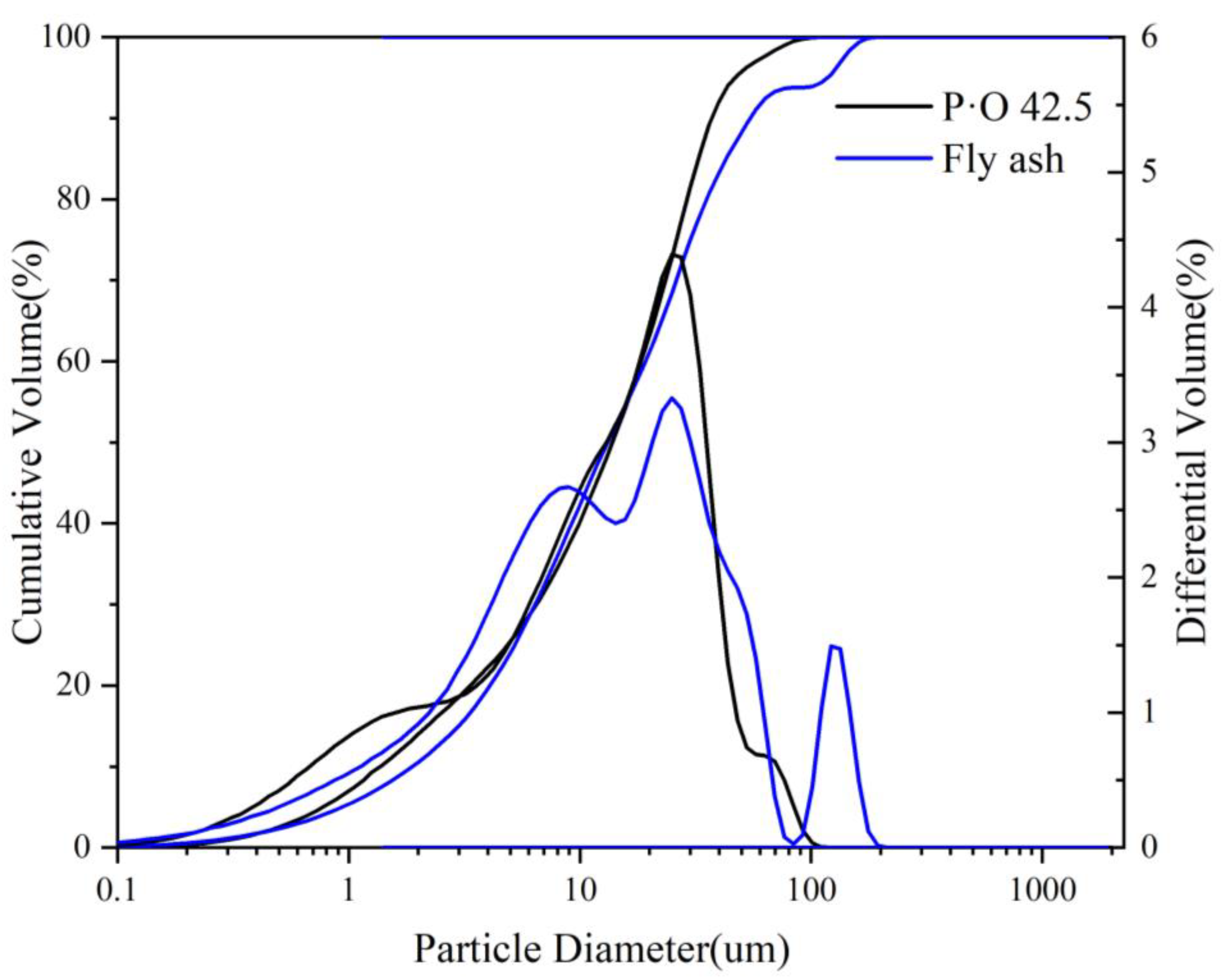
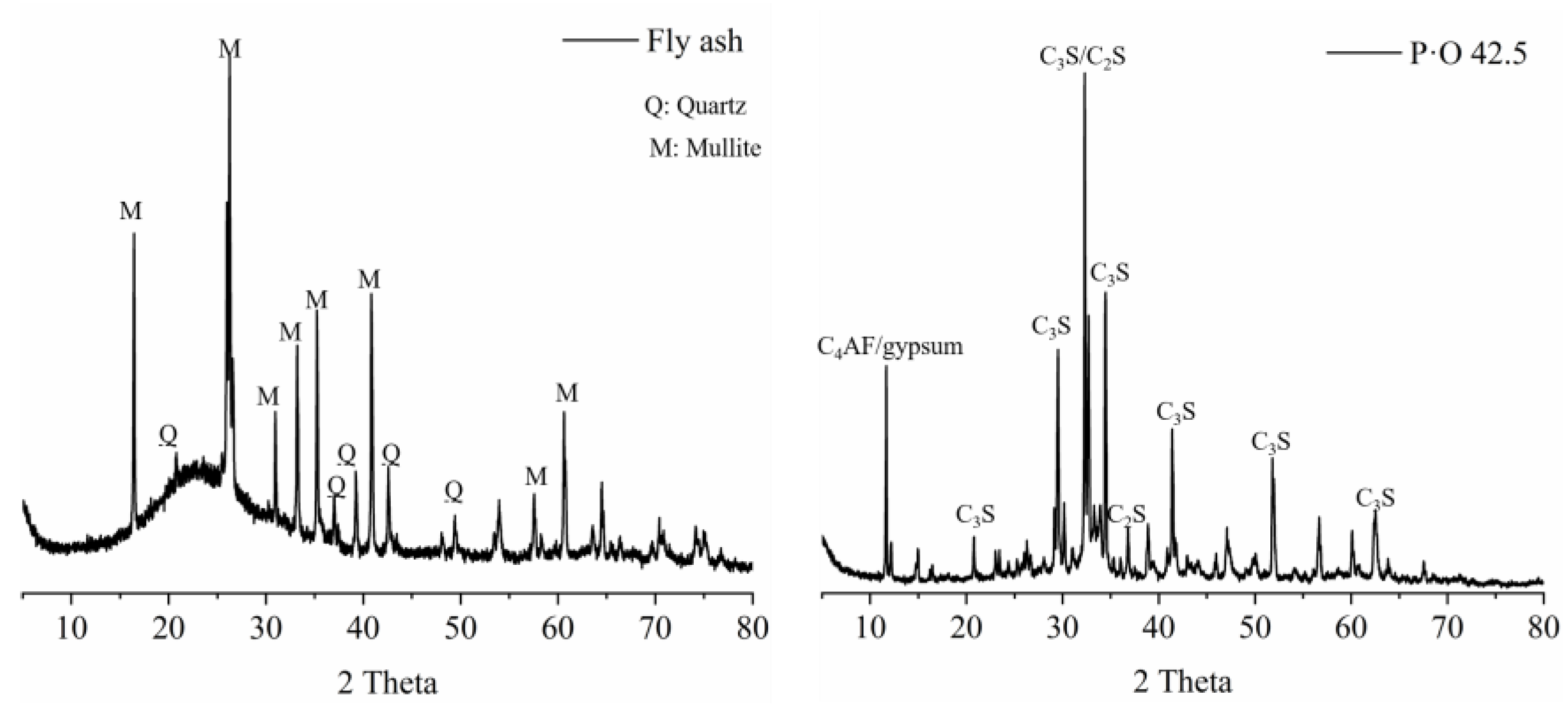

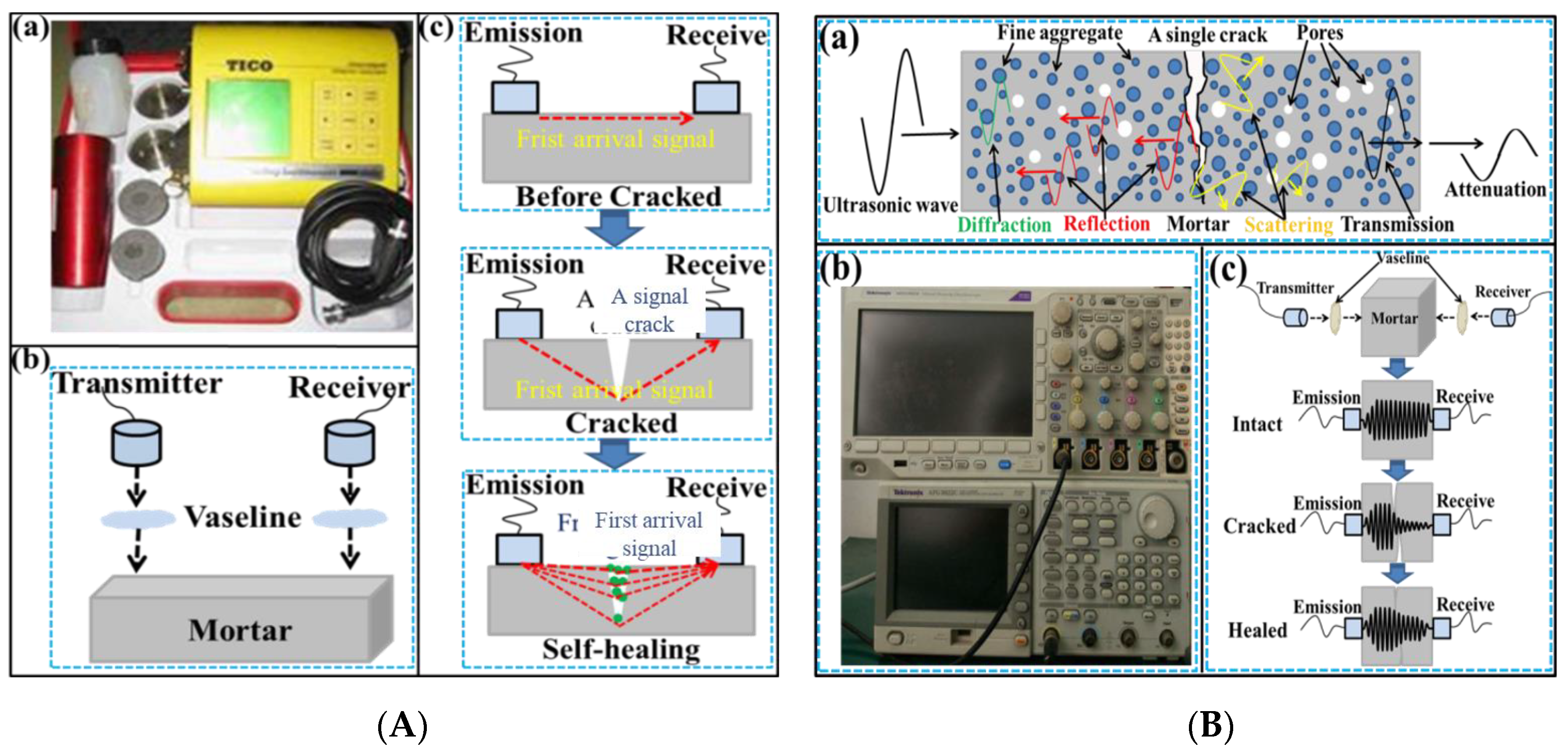
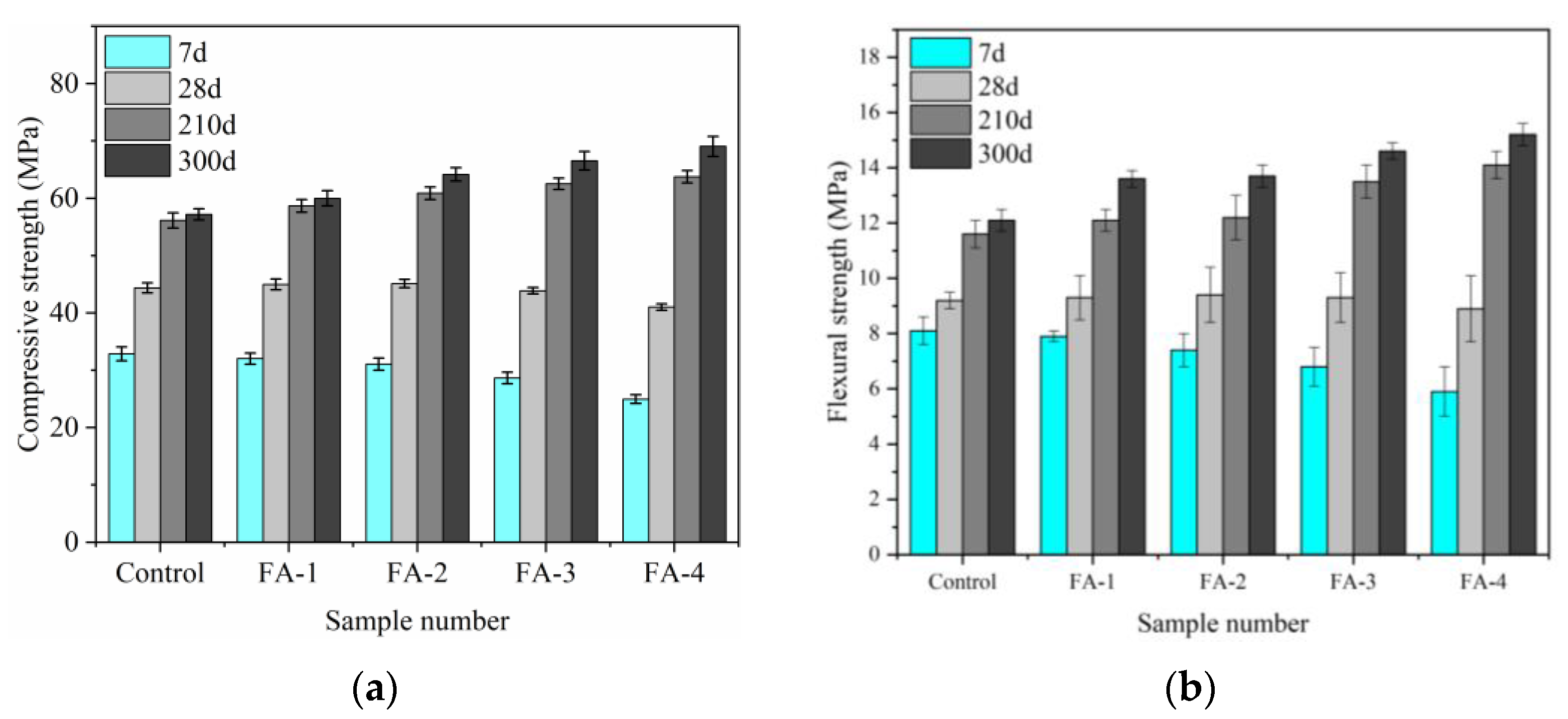
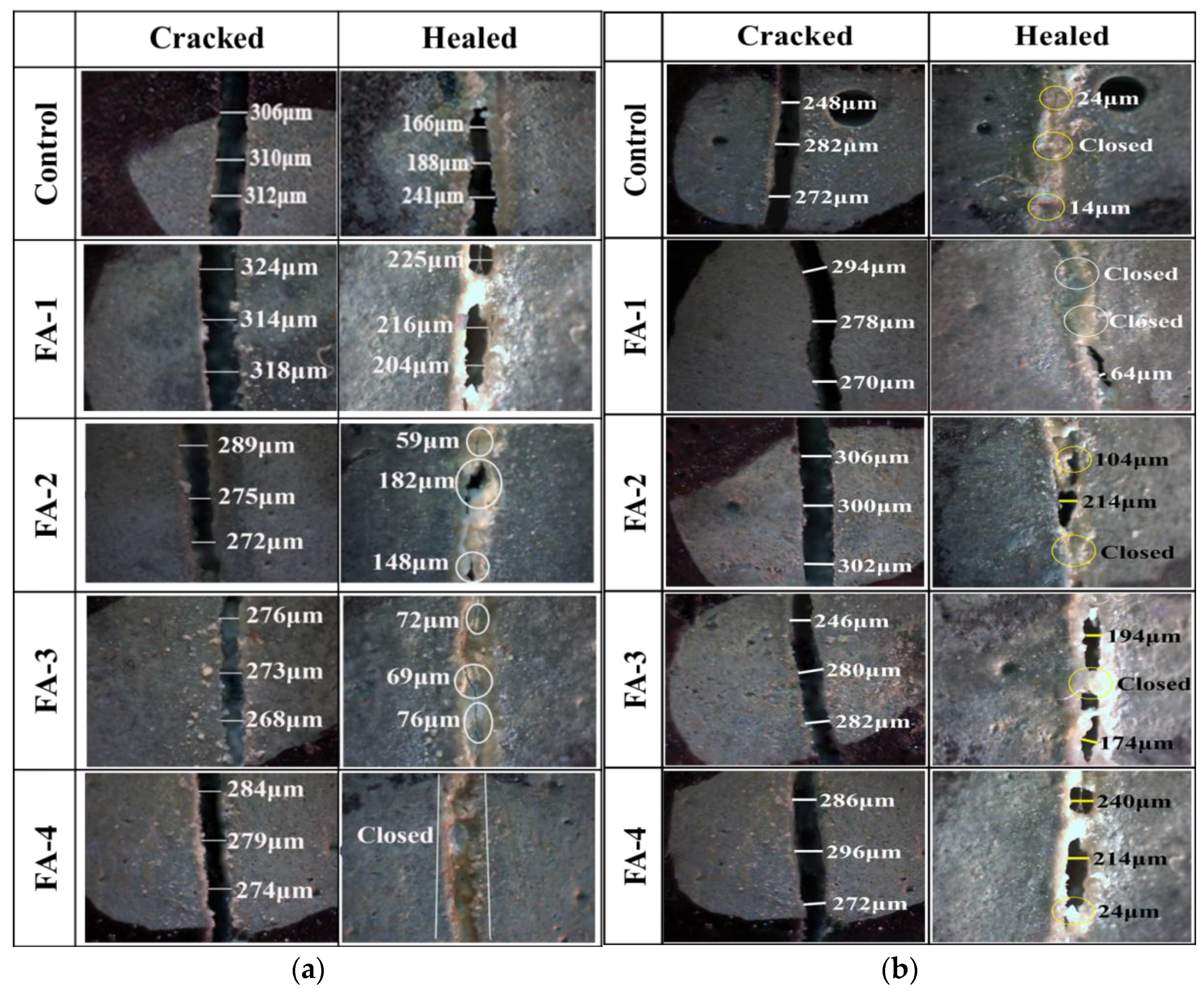
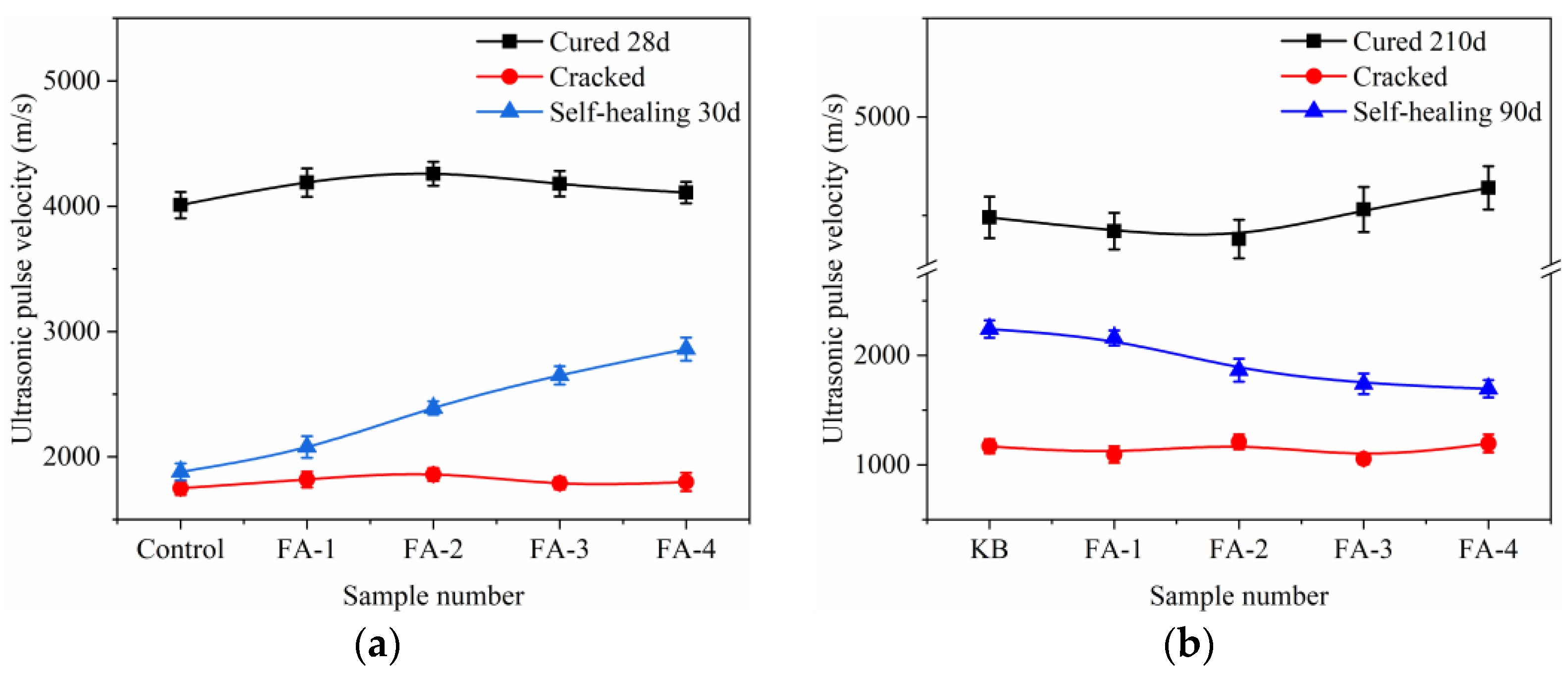

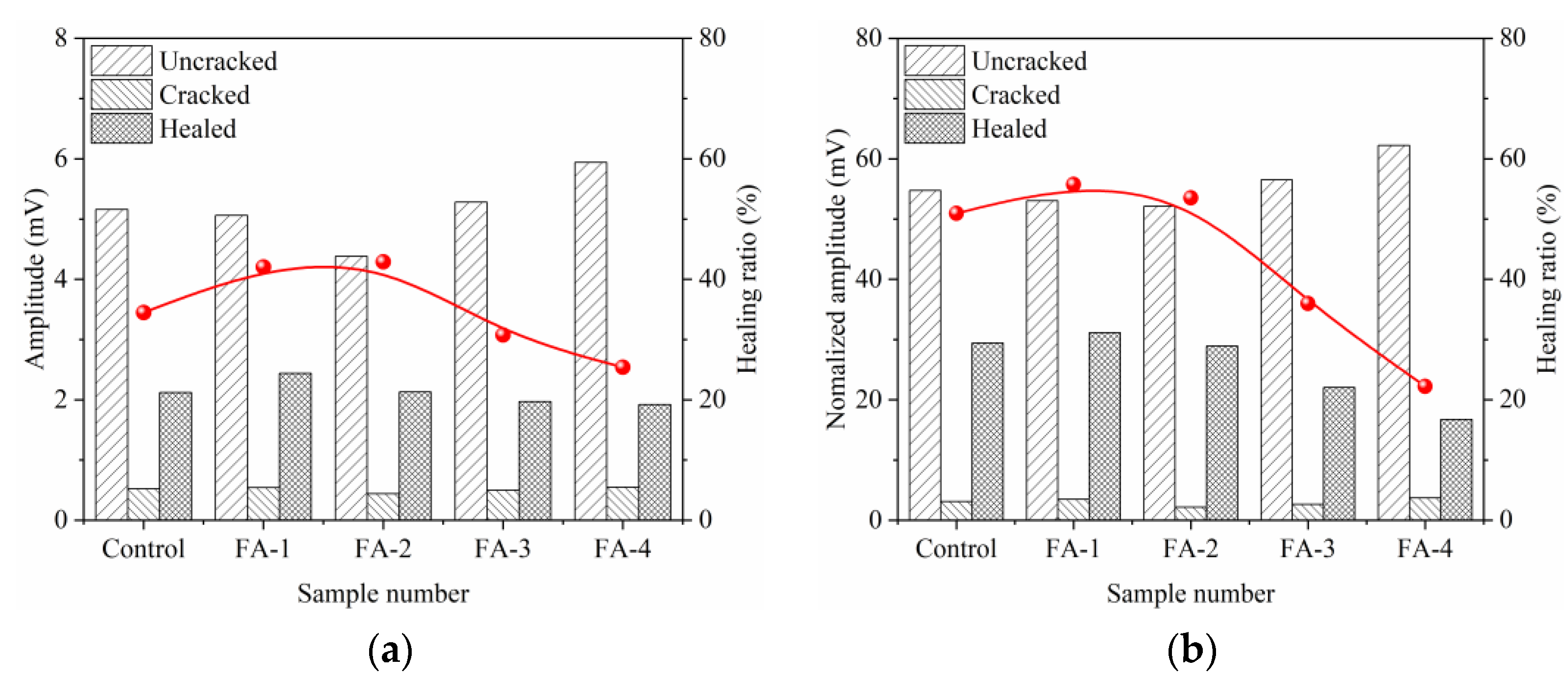
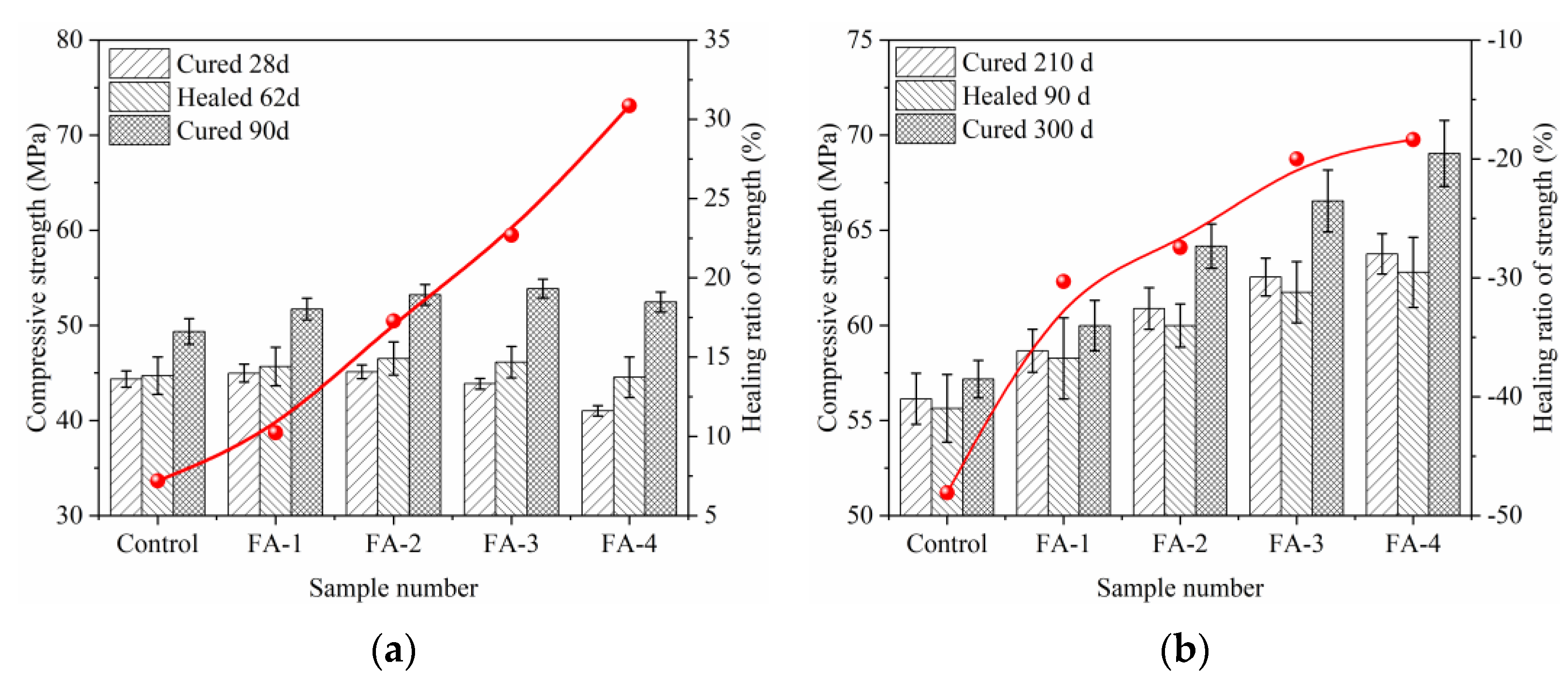

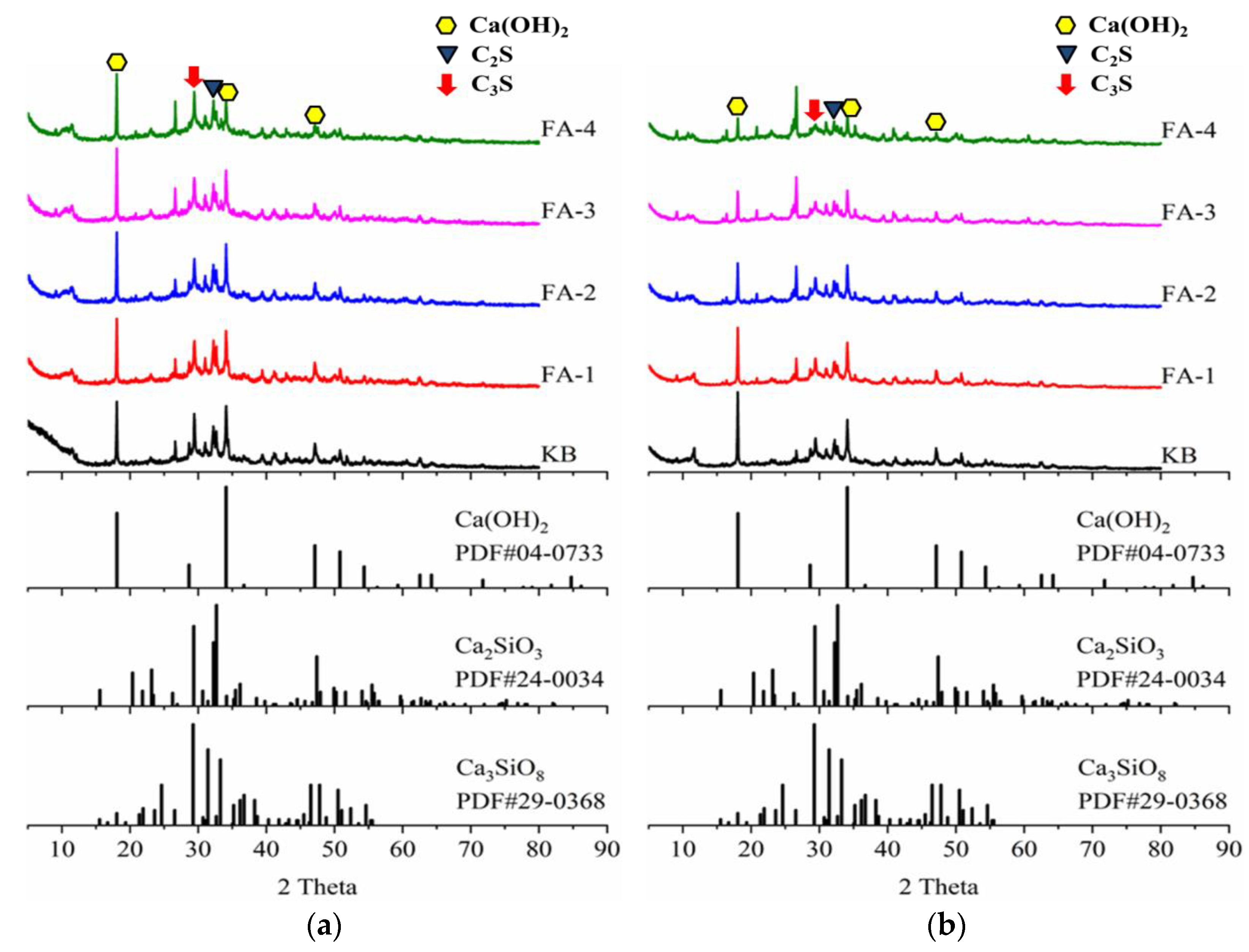
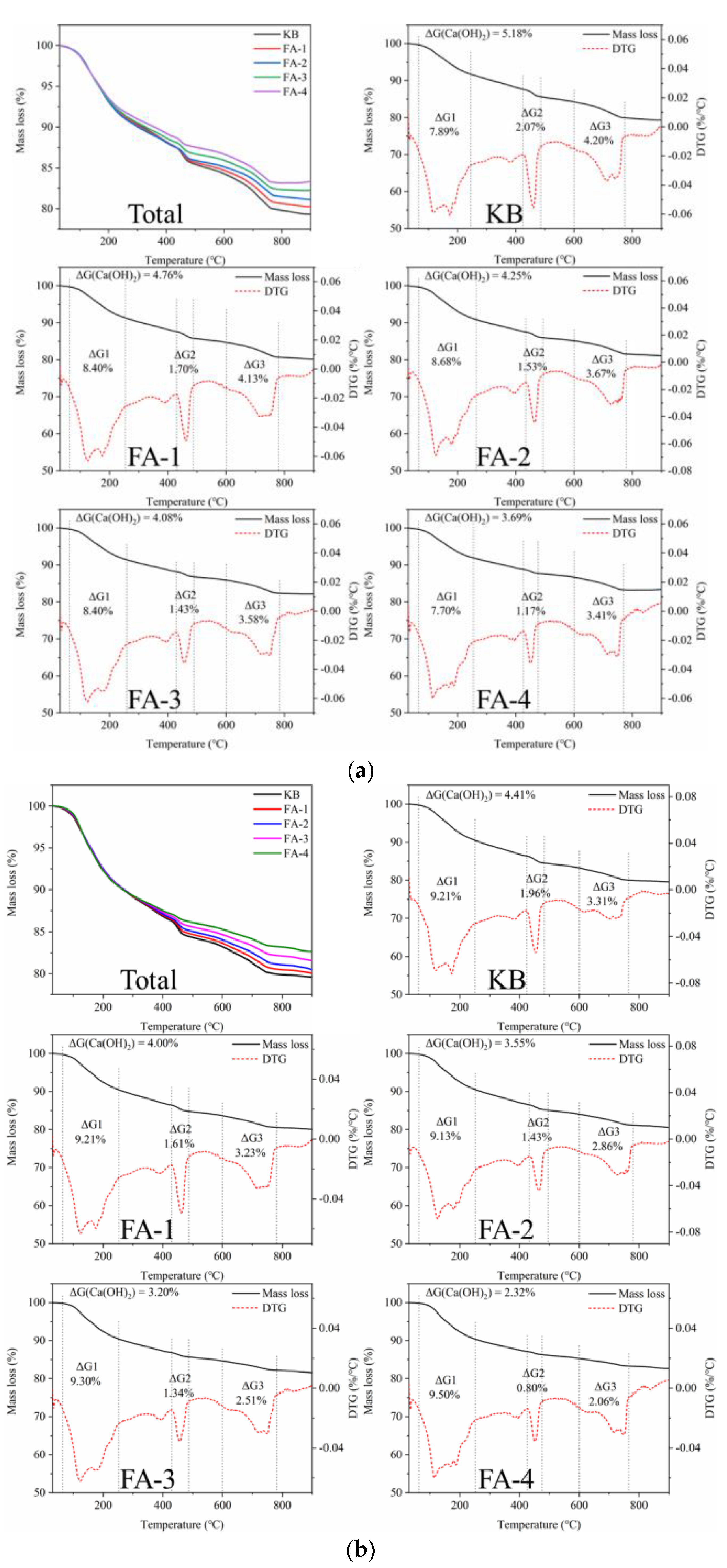
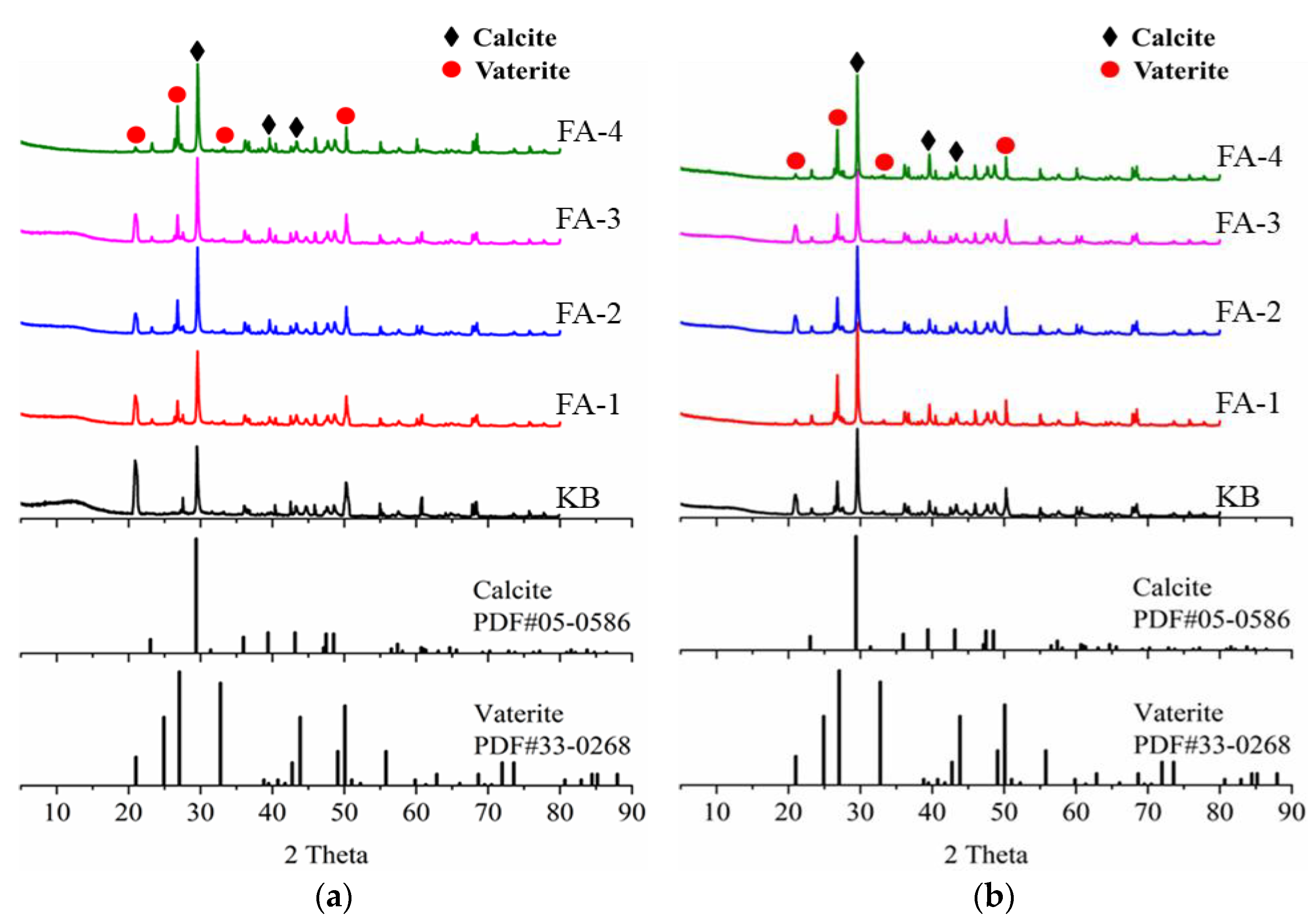
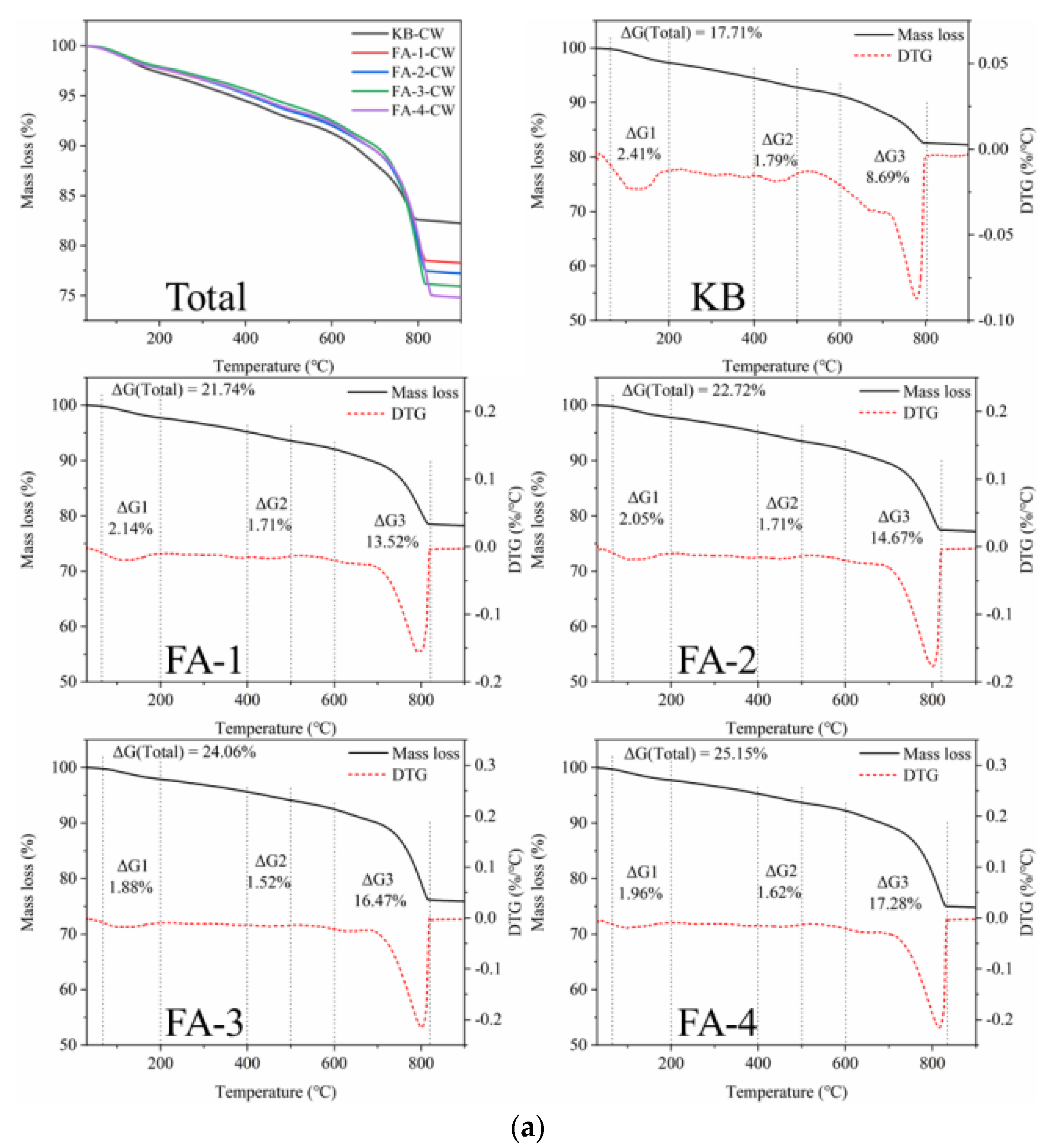
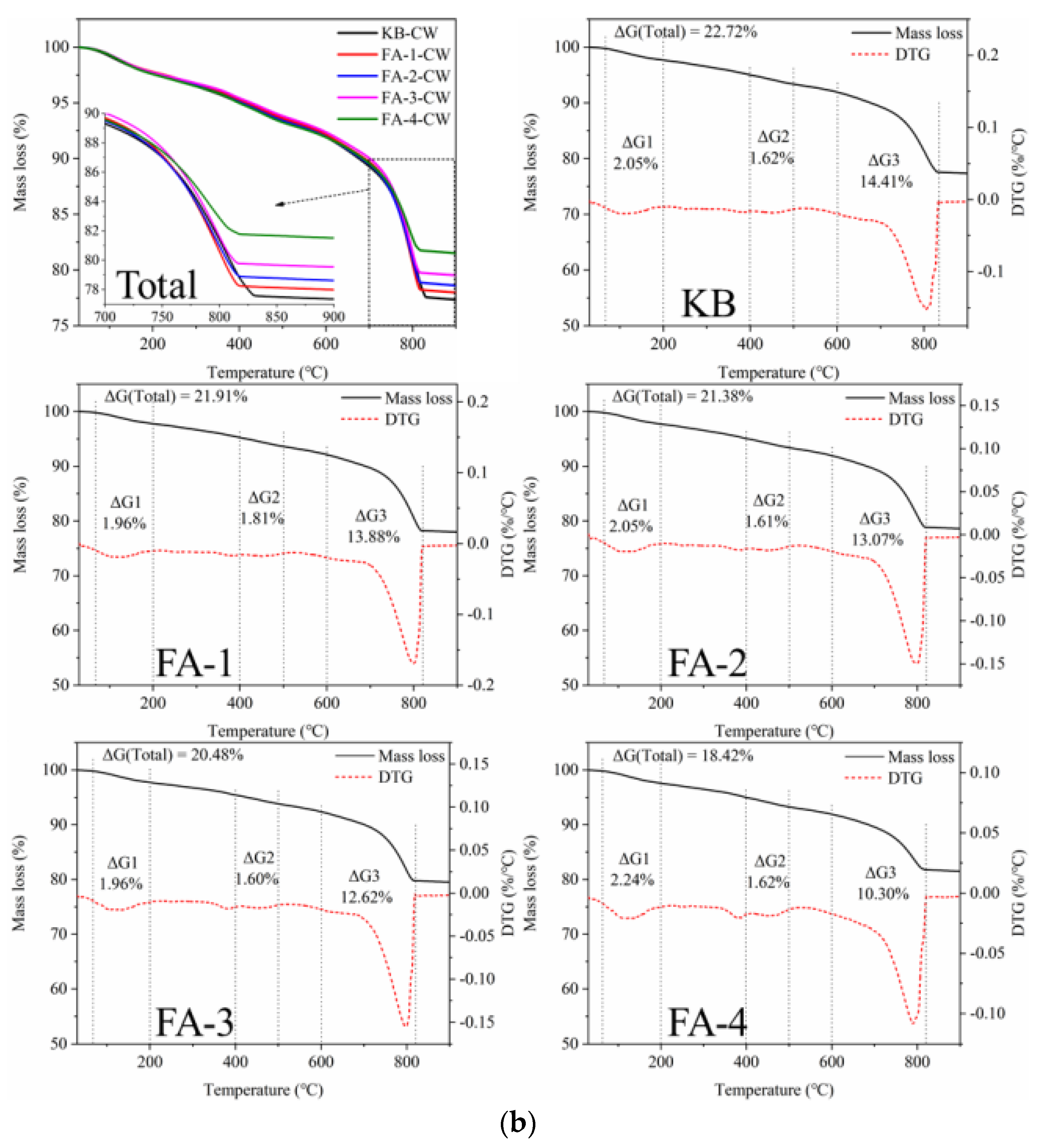


| Compositions | CaO | SiO2 | Al2O3 | MgO | Fe2O3 | SO3 | Others | Specific Surface Area (m²/kg) |
|---|---|---|---|---|---|---|---|---|
| P·O 42.5 | 57.82 | 22.16 | 6.36 | 2.94 | 2.78 | 4.20 | 3.74 | 346 |
| fly ash | 3.57 | 48.59 | 37.08 | 0.36 | 5.24 | 0.34 | 4.82 | 445 |
| Size Distribution (mm) | ≤0.15 | 0.15~0.3 | 0.3~0.6 | 0.6~1.18 | 1.18~2.36 | 2.36~4.75 |
| Content (%) | 11 | 21 | 27 | 24 | 12 | 5 |
| No. | Cement/g | Fly Ash/g | Water/g | River Sand/g |
|---|---|---|---|---|
| Control | 450 | 0 | 150 | 1350 |
| FA-1 | 405 | 45 | ||
| FA-2 | 360 | 90 | ||
| FA-3 | 315 | 135 | ||
| FA-4 | 270 | 180 |
| Mechanisms | Conditions and Results | |||
|---|---|---|---|---|
| Presence of water in cracks | Presence of ions in cracks | Upper crack width that can be repaired | Compressive strength | |
| Autogenous self-healing | In a watery environment | Not necessary. However, the presence of is better. | Less than 50 μm | Compressive strength loss decreases from 27% to 7% [14,34] |
| Self-healing based on mineral admixtures | In a watery environment | Not necessary. | About 200 μm | Recovering 85%/(74%) of initial resonant frequency [35] |
| Self-healing based on bacteria | In a watery environment | ion is needed | Less than 450 μm | A slight increase in 28 d of curing. [36] |
| Self-healing based on adhesive agents | In most cases, cracks should be in a watery environment | Not necessary. | Depending on the amount of agents released | Depending on healing agent [37]. |
Disclaimer/Publisher’s Note: The statements, opinions and data contained in all publications are solely those of the individual author(s) and contributor(s) and not of MDPI and/or the editor(s). MDPI and/or the editor(s) disclaim responsibility for any injury to people or property resulting from any ideas, methods, instructions or products referred to in the content. |
© 2023 by the authors. Licensee MDPI, Basel, Switzerland. This article is an open access article distributed under the terms and conditions of the Creative Commons Attribution (CC BY) license (https://creativecommons.org/licenses/by/4.0/).
Share and Cite
Luan, C.; Yuan, L.; Wang, J.; Zhou, Z. Uncovering the Mechanism of the Role of Fly Ash in the Self-Healing Ability of Mortar with Different Curing Ages. Materials 2023, 16, 3453. https://doi.org/10.3390/ma16093453
Luan C, Yuan L, Wang J, Zhou Z. Uncovering the Mechanism of the Role of Fly Ash in the Self-Healing Ability of Mortar with Different Curing Ages. Materials. 2023; 16(9):3453. https://doi.org/10.3390/ma16093453
Chicago/Turabian StyleLuan, Congqi, Lianwang Yuan, Jinbang Wang, and Zonghui Zhou. 2023. "Uncovering the Mechanism of the Role of Fly Ash in the Self-Healing Ability of Mortar with Different Curing Ages" Materials 16, no. 9: 3453. https://doi.org/10.3390/ma16093453
APA StyleLuan, C., Yuan, L., Wang, J., & Zhou, Z. (2023). Uncovering the Mechanism of the Role of Fly Ash in the Self-Healing Ability of Mortar with Different Curing Ages. Materials, 16(9), 3453. https://doi.org/10.3390/ma16093453





